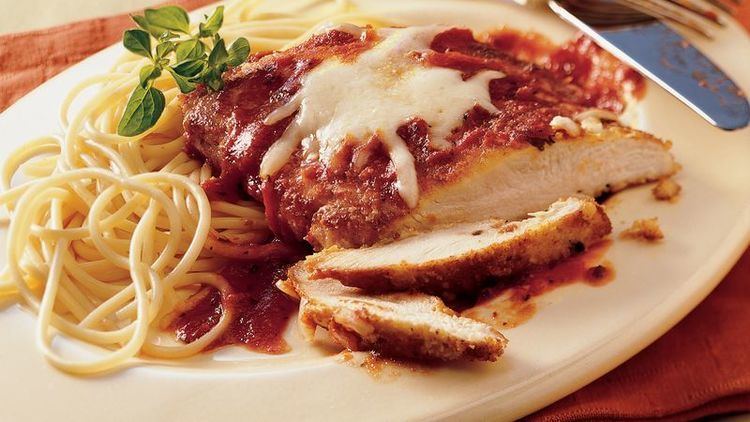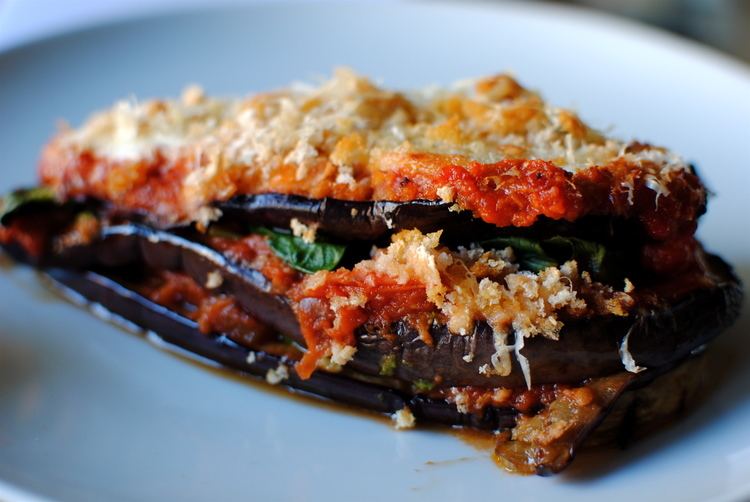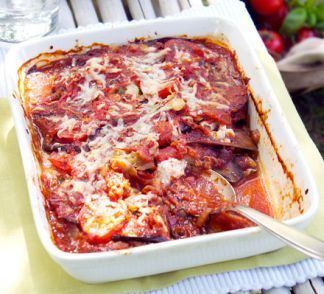Origins Italy, Apulia | Variations Veal, Chicken | |
 | ||
Similar Parmigiano‑Reggiano, Marinara sauce, Mozzarella, Chicken parmigiana, Fettuccine Alfredo | ||
Eggplant parmigiana my favorite dish italian recipe gianni s north beach
Parmigiana ( /ˌpɑːrməˈʒɑːnə/, /ˌpɑːmɪˈdʒɑːnə/; [parmiˈdʒaːna]; also parmigiana di melanzane [parmiˈdʒaːna di melanˈdzaːne; -ˈtsa-], or melanzane alla parmigiana [melanˈdzaːne alla parmiˈdʒaːna; -ˈtsa-] or shortened as parmy, in American English called eggplant parmesan) is an Italian dish made with a shallow or deep-fried sliced aubergine (also called eggplant) filling, layered with cheese and tomato sauce, then baked. Parmigiana made with a filling of eggplant is the earliest and still unique Italian version. Other variations may include chicken, veal, or another type of meat cutlet or vegetable filling. The origin of the dish is claimed by both the Southern regions of Campania and Sicily.
Contents
- Eggplant parmigiana my favorite dish italian recipe gianni s north beach
- Classic italian chicken parmigiana recipe emeril s classic dishes emeril lagasse
- Preparation
- International variations
- References

Classic italian chicken parmigiana recipe emeril s classic dishes emeril lagasse
Preparation

The dish consists of a sliced filling pan fried in oil, layered with tomato sauce and cheese, and baked in an oven. In some versions, the sliced filling is first dipped in beaten eggs and dredged in flour or breadcrumbs before frying. Some recipes use hard grated cheeses such as Parmigiano, while others use softer melting cheeses like mozzarella, or a combination of these.
International variations

Variations made with breaded meat cutlets, such as veal and chicken, have been popularized in other countries, usually in areas of Italian immigration.

In the United States and Canada, veal parmigiana or chicken parmigiana is often served as an entree, and sometimes is served as a submarine sandwich. It is also popular with a side of or on top of pasta. Diced onions or green bell peppers, sauteed or raw, are sometimes added. A similar veal dish is known in Italian as Cotolette alla Bolognese., however, traditional Italian recipes exclude tomato sauce from the dish. Costelette Parmigiana is another related veal dish, however, in Italy it is generally served without sauce or cheese.
Veal or chicken parmigiana is a common dish in Australia and Argentina and in both countries often served with a side of chips or salad. In Australia, it may also contain a variety of toppings, including sliced ham or fried eggplant (aubergine) slices.
In Argentina and in other neighboring South American countries, veal or chicken parmigiana is topped with ham and served with french fries. It is known as milanesa a la napolitana. If the dish is topped with a fried egg, then it is known as a súper milanesa or suprema napolitana. The origin of the dish was the Napoli restaurant in Buenos Aires during the 1940s. (See also Milanesa napolitana (Spanish).)
A similar dish, the parmo, which uses either pork or chicken, has developed in England.
In Brazil, Parmigiana is a popular restaurant dish, which was brought over by Italian immigrants (Brazil having the largest population of such immigrants in the world). There are three kinds of Parmigiana in Brazil: filé de frango a parmigiana (chicken fillet parmigiana), berinjela a parmigiana (eggplant parmigiana) and meat parmigiana. Three types of beef are used to make meat parmigiana: two prime cuts, yielding, respectively, filé mignon à parmigiana (tenderloin parmigiana) and contra-filé à parmigiana (sirloin steak parmigiana), while the third type, yielding bife à parmigiana, is simply beef of an unspecified cut. In Brazil, Parmigiana dishes are usually served with either white rice and fried potatoes or with pasta in a tomato sauce.
